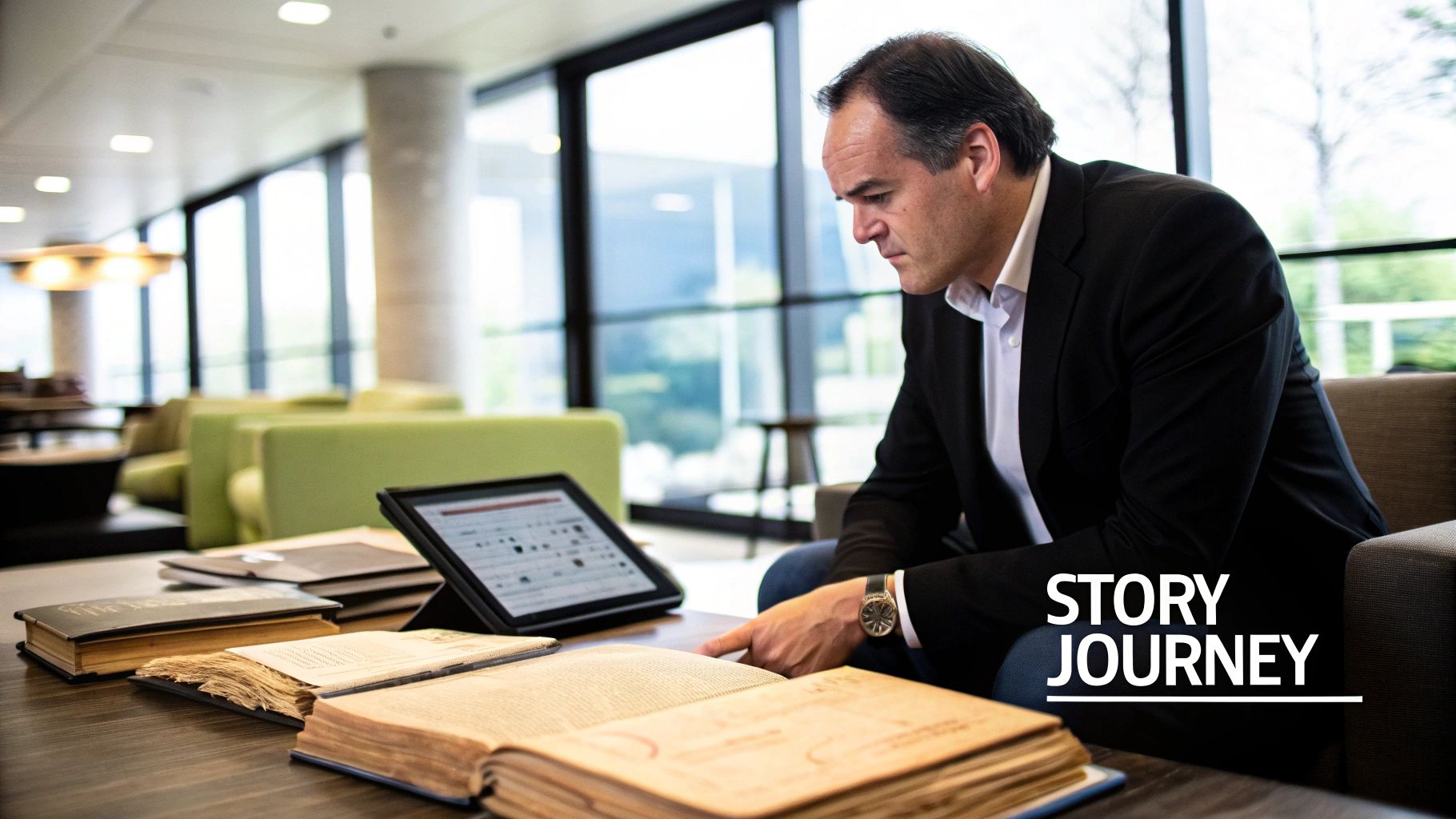Why Your Personal Mission Statement Matters
Navigating life's complexities can feel overwhelming without a clear sense of direction. It's easy to get caught up in external pressures, leading to choices that don't truly serve us. A personal mission statement acts as your internal compass, guiding you through decisions and ensuring your actions align with your core values.
This goes beyond simple goal-setting. It's about defining your overall purpose. A personal mission statement provides clarity when facing conflicting priorities. For example, imagine a promotion requiring extensive travel. If family time is prioritized in your mission statement, it can help you make a decision aligned with your values.

These statements also maintain focus during change. Career transitions, setbacks, or even significant success can be disorienting. A well-defined personal mission statement anchors you, providing stability amidst turbulence. You're less likely to be swayed by fleeting trends that deviate from your path.
This sense of purpose translates to tangible benefits, both professionally and personally. It empowers you to pursue opportunities with intention and make difficult choices with confidence. Ultimately, it leads to a more authentic and fulfilling life. Creating a personal mission statement helps evaluate and identify basic values, simplifying decision-making. As of 2019, this involved reflecting on successes and valued traits to define life's priorities. Learn more about personal mission statement success factors here.
The Power of Alignment
A personal mission statement isn't just about positive feelings. It's about aligning actions with values. This creates integrity and authenticity, leading to increased self-awareness and a stronger sense of self.
Navigating Challenges With Purpose
Life inevitably presents challenges. A personal mission statement equips you with resilience. It serves as a reminder of your core principles, helping you navigate difficult decisions and stay true to yourself, even under pressure.
Unlocking Your Potential
By defining your purpose, a personal mission statement unlocks your potential. It focuses your energy on what truly matters, leading to greater productivity, improved relationships, and a deeper sense of fulfillment. This creates a positive feedback loop, strengthening your commitment to your purpose.
Crafting Your Statement: A Step-by-Step Blueprint
Turning deep self-reflection into a concise, powerful personal mission statement can be challenging. This section breaks the process into actionable steps, offering a template to guide you. Through practical exercises and prompting questions, you'll uncover your core values, articulate your strengths, and define the impact you wish to make.
Identifying Your Core Values
First, think about what truly matters to you. What principles drive your choices and actions? These are your core values. Is integrity essential? Does creativity or community involvement drive your passion? Recognizing these foundational elements forms the basis of your mission statement.
Articulating Your Strengths
Next, identify your unique strengths. What comes naturally to you? Which skills have you developed? Acknowledging these abilities helps define your contribution to the world. This is about understanding your capabilities and how they align with your values, not bragging.
Defining Your Impact
Now, visualize the positive change you want to create in your personal and professional life. Do you aspire to inspire others? To innovate in your field? Clearly defining your desired impact shapes your mission statement, clarifying your purpose and directing your actions.
Writing a personal mission statement involves understanding your passions, values, and goals. It means identifying what's most important and how your life connects to those values. Articulating personal and professional aspirations is also key. This self-reflection helps you define the qualities you want to embody and where you see yourself in the future. Explore this topic further here.
Overcoming Common Roadblocks
Many struggle with perfectionism and vague language when creating a personal mission statement. Don't get stuck in endless revisions. Begin with a draft and refine it over time. Use specific, action-oriented language and avoid generic phrases. This will make your statement more powerful and actionable.
Testing and Refining Your Statement
Once you have a draft, test it. Does it resonate with you? Does it accurately reflect your values, strengths, and desired impact? Share it with trusted friends or mentors for feedback. Refine it as you grow, ensuring it stays authentic and relevant to your journey. This iterative process makes your mission statement stronger.

A Practical Personal Mission Statement Template
A helpful starting point is structuring your statement around these core components:
To help you create a compelling personal mission statement, let's look at the essential components:
| Component | Description | Why It Matters |
|---|---|---|
| Values | 2-3 core values that guide you. | These are the fundamental principles that drive your decisions and actions, shaping who you are and how you interact with the world. |
| Strengths | 2-3 key strengths you possess. | Understanding your strengths allows you to leverage your natural abilities and honed skills to achieve your goals and make a meaningful contribution. |
| Impact | The positive change you want to create. | Defining your desired impact provides direction and purpose, focusing your efforts on making a difference in areas that resonate with you. |
| Action | How you will achieve your impact. | This outlines the tangible steps you'll take to achieve your desired impact, turning your aspirations into concrete actions. |
This table summarizes the essential building blocks of a personal mission statement, providing a clear framework for crafting your own. By considering each component carefully, you can create a statement that truly reflects your values, strengths, and aspirations.
- Values: List 2-3 core values that guide you (e.g., Integrity, Creativity, Growth).
- Strengths: Identify 2-3 key strengths you possess (e.g., Problem-solving, Communication, Empathy).
- Impact: Describe the positive change you want to create (e.g., Empower others, Drive innovation, Foster community).
- Action: State how you will achieve your impact (e.g., By mentoring aspiring professionals, By developing innovative solutions, By building bridges between diverse groups).
Combine these elements into a concise statement. For example: "Guided by integrity and fueled by creativity, I empower others to achieve their full potential by providing mentorship and fostering a supportive community."
Remember, this is a template. Adapt it to your needs and preferences. The most important thing is that it resonates with you and serves as a guiding principle for your life. Through thoughtful crafting and regular review, your personal mission statement becomes a powerful tool for self-discovery, growth, and fulfillment.
Mission Statement Templates for Every Life Stage

Just as your career evolves, so does your purpose in life. A personal mission statement isn't set in stone; it grows with you. This means a flexible personal mission statement template becomes incredibly valuable. Whether you're just starting your career or a seasoned executive, a template offers a framework for defining your path.
Early Career Professionals
Starting out in your career can feel overwhelming. A personal mission statement template offers valuable direction. It helps you explore different roles and industries. At this stage, focus on skill development, networking, and identifying your long-term career goals.
- Example: "To continuously learn and grow within the tech industry, building a strong network and contributing to projects that have a positive impact."
Mid-Career Professionals
Mid-career is a time for reflection. A personal mission statement template can guide you through this transition. This stage often involves balancing work and personal life, developing leadership skills, and making a real difference in your chosen field.
- Example: "To use my project management skills to lead successful teams, while maintaining a healthy work-life balance and mentoring junior colleagues."
New Parents
Becoming a parent changes everything. A personal mission statement template helps you integrate this new role into your life. This stage focuses on managing family and work responsibilities, being a role model for your children, and creating a happy, healthy family life.
- Example: "To be a supportive parent, helping my children grow while continuing to contribute to my career and building a strong partnership with my spouse."
Entrepreneurs
For entrepreneurs, a personal mission statement template defines both personal and business values. It emphasizes innovation, delivering value to customers, and creating a sustainable, ethical business.
- Example: "To build a thriving business that helps small business owners through innovative marketing, prioritizing ethical practices and supporting the community."
To help illustrate these differences, take a look at the table below:
This table, "Comparing Personal Mission Statement Templates by Life Stage," shows how these templates can be adapted for different career points and personal situations. It highlights what's important at each stage.
| Life Stage | Key Focus Areas | Template Structure | Example Phrases |
|---|---|---|---|
| Early Career | Skill development, Networking, Identifying long-term aspirations | Action-oriented, focused on growth and exploration | "Continuously learn," "Build a strong network," "Contribute to innovative projects" |
| Mid-Career | Work-life balance, Leadership development, Meaningful contribution | Balanced approach, emphasizing both professional and personal growth | "Leverage expertise," "Lead high-performing teams," "Maintain work-life integration" |
| New Parents | Balancing personal and professional responsibilities, Setting a positive example, Family well-being | Integration-focused, acknowledging the shift in priorities | "Be a present parent," "Nurture children's growth," "Maintain a strong partnership" |
| Entrepreneurs | Innovation, Creating customer value, Building a sustainable and ethical business | Vision-oriented, outlining the core values of the business and the entrepreneur | "Build a successful business," "Empower others," "Prioritize ethical practices" |
As shown in the table, each life stage presents unique challenges and opportunities that require a tailored approach to defining your mission.
Adapting Your Personal Mission Statement
It's important to update your personal mission statement when needed. Life changes, career shifts, or changes in your values might mean it's time for a refresh. This doesn't mean abandoning your core beliefs. Small tweaks can realign your statement with your current circumstances.
For example, if you shift your focus from career advancement to community work, you can adjust your statement accordingly while still maintaining your core values. This makes sure your personal mission statement stays relevant and guides you throughout your life.
Recognizing the Need for Change
Several things can indicate your personal mission statement needs a review. Feeling unfulfilled, conflicts with your values, or a lack of motivation might suggest your statement no longer reflects your purpose. Regularly review and adapt your statement to ensure it continues to guide you effectively.
Leveraging Your Mission Statement For Career Growth

A personal mission statement provides more than just personal clarity. It's a powerful tool for career advancement, helping you make strategic career decisions aligned with your core values and aspirations. This can lead to increased job satisfaction and overall success.
Aligning Your Mission With Career Opportunities
Your personal mission statement acts as a filter when evaluating career opportunities. It helps identify roles and organizations that truly resonate with your purpose. For example, if your mission emphasizes innovation, you might be drawn to startups or companies known for robust research and development. This focus allows you to pursue opportunities genuinely reflecting your values.
Understanding your mission also helps identify misaligned situations. Recognizing these misalignments early prevents wasted time and energy in roles that ultimately lead to dissatisfaction. This awareness empowers you to make choices that support your long-term career goals and personal fulfillment.
Furthermore, a strong sense of purpose improves performance. Employees driven by purpose are 12% more productive. This sense of purpose can be cultivated through personal mission statements that resonate with organizational values. Find more detailed statistics here: https://nailted.com/blog/employee-engagement-statistics/. This powerful connection between purpose and productivity highlights the importance of integrating your mission into your career strategy.
Integrating Your Mission Into Career Conversations
A personal mission statement helps articulate your value proposition during job interviews, performance reviews, and salary negotiations. Connecting your skills and experience to your mission demonstrates authenticity and passion. This approach helps you stand out and make a lasting impression.
It's crucial, however, to integrate your mission naturally. Avoid simply reciting your statement. Instead, weave its core principles into your responses. For example, when discussing career goals, explain how they contribute to your overall mission. This subtle approach demonstrates commitment without sounding rehearsed.
Navigating Workplace Challenges With Integrity
Your personal mission statement can also guide you through challenging workplace situations. It helps maintain integrity and make decisions aligned with your values, even when under pressure. This is particularly helpful when facing ethical dilemmas or conflicts.
A clear understanding of your mission can empower you to advocate for yourself and your team. By articulating your needs and priorities in a way that aligns with your purpose, you can effectively negotiate for resources, opportunities, and support.
Making Long-Term Career Decisions
Finally, your personal mission statement provides a framework for making long-term career decisions. It helps evaluate different career paths and choose the one that best aligns with your overall goals and values. This long-term perspective helps avoid short-sighted choices.
By grounding your decisions in your mission, you create a fulfilling and sustainable career path. This approach ensures that your professional journey aligns with your deeper sense of purpose, leading to greater satisfaction and long-term success.
Modern Values in Your Personal Mission Template
A personal mission statement template isn't a dusty old document; it's a living guide that should reflect your current values. This includes modern priorities like work-life balance, mental wellness, and making a positive impact. This section explores how to weave these contemporary values into your personal mission statement.
Balancing Ambition With Well-Being
Traditional mission statements often fixated solely on achievement. Today, we recognize the importance of mental and physical well-being. This means setting boundaries, prioritizing self-care, and acknowledging that success isn't just about external accomplishments. Your personal mission statement template should reflect this. For example, "To achieve ambitious goals while prioritizing my mental and physical health" acknowledges both drive and well-being.
Integrating Social Responsibility
More and more, people want their lives to have meaning beyond personal gain. This means considering your impact on the world. Adding social responsibility to your template might involve community involvement, promoting ethical practices, or supporting causes you believe in. This gives your mission greater depth, reflecting a commitment to something bigger than yourself.
Acknowledging Broader Contexts
Your experiences are shaped by your background, including your culture, socioeconomic status, and current events. Recognizing these influences in your personal mission statement adds a powerful dimension. It deepens your self-understanding and how you fit into the world. It also shows you recognize life's complexities and demonstrates a commitment to inclusivity. Recent data highlights this shift: 82% of employees want their organization to see them as whole people, not just workers. Unfortunately, only 45% feel this is happening. Learn more from Gartner.
Maintaining Authenticity and Individuality
While integrating these values is important, your mission statement should still be uniquely you. Use language that resonates with you, reflecting your individual voice and values. Avoid generic phrases. Your statement should feel authentic and inspire you.
Navigating Value Conflicts
Sometimes, modern values might seem to clash. A demanding career, for example, might feel at odds with family time. Your personal mission statement can be your guide. By clearly defining your priorities, it helps you navigate these conflicts and make decisions aligned with your core values.
Examples of Modern Values in Action
Consider these examples:
- Work-Life Integration: "To excel in my career while maintaining a healthy work-life balance, prioritizing quality time with loved ones."
- Mental Well-being: "To pursue my passions with resilience and self-compassion, prioritizing my mental health and fostering positive relationships."
- Social Impact: "To use my skills and experience to contribute to positive social change, advocating for environmental sustainability and supporting underserved communities."
Creating a Living Document
Your personal mission statement isn't set in stone. As you grow and change, so should your mission statement. Regularly review and revise your template to ensure it reflects your current priorities and aspirations. This makes it a relevant and powerful guide throughout your life. It's a framework for making choices aligned with your deepest values, leading to a fulfilling life of purpose and authenticity.
Mission-Driven Leadership: Beyond Personal Success
Strong leadership involves more than just skills and knowledge. Truly effective leaders possess a deep sense of purpose that directs their actions and inspires their teams. This sense of purpose is often best expressed through a personal mission statement. By understanding how personal mission statements improve leadership, we can unlock higher levels of team performance and achieve significant results.
Aligning Team Objectives With Your Authentic Purpose
Your personal mission statement can be a valuable tool for aligning team objectives. This isn't about forcing your beliefs onto your team. Instead, it’s about clearly communicating your vision and encouraging your team to connect their work to a larger purpose. For example, if innovation is central to your mission, you can motivate your team to explore creative solutions and embrace new ideas, creating a culture of continuous improvement.
Building Trust and Psychological Safety
Sharing your mission openly with your team builds trust and creates a psychologically safe environment. When team members understand your motivations and values, they’re more likely to share their own perspectives and ideas. This open communication strengthens collaboration and creates a more unified work environment. It also fosters a sense of shared purpose, boosting engagement and motivation.
This focus on personal missions extends beyond individual development. It significantly impacts leadership as well. Annette Gregg, CEO of SITE, emphasizes the importance of personal missions beyond professional roles. She shares her experience developing a personal mission statement after a career setback, which helped her regain confidence and clarify her priorities. Learn more about incentives, trends, and personal missions here.
Encouraging Mission Development Within Your Team
Strong leaders not only have their own mission statements but also encourage their team members to develop their own. Providing guidance and support helps team members define their individual purposes and connect them to the team’s overall goals. This promotes a sense of ownership and responsibility, resulting in greater engagement and improved work quality. Workshops or individual coaching sessions can be valuable resources during this process.
Creating a Purpose-Driven Work Environment
Mission-driven leadership requires creating an environment where purpose thrives. This involves fostering a culture of open communication, collaboration, and continuous learning. By celebrating successes and acknowledging contributions, you reinforce the importance of purpose and create a positive, motivating atmosphere.
Beyond Conventional Success Metrics
Mission-driven leadership achieves results that go beyond traditional metrics. When teams share a common purpose, they’re more likely to produce innovative work, build strong relationships, and positively impact the organization and the community. This comprehensive approach to leadership creates a more fulfilling and sustainable experience for everyone. It cultivates continuous growth and innovation, ensuring long-term success and positive influence. This style of leadership builds a sense of belonging and shared purpose, crucial for navigating the complexities of the business world.
Ready to transform your leadership and achieve meaningful results? Discover how Bhavik Sarkhedi & Co. can help you develop a compelling personal brand narrative and content strategy. Visit their website today and unlock the power of purpose-driven leadership.



















